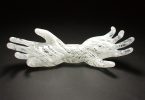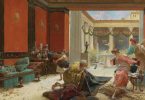Darülbedayi, long-established theatre institution in the western sense, is in fact proof that theatre is not foreign to us. The history of the theatre in Anatolian lands actually goes way back in time. The Anatolian tradition, in which the foundations of ancient theatre had been set and a verbal culture was dominant, theatre continued its existence with its theatrical plays, light comedy shows, public storytelling and shadow shows, until the end of the Ottoman era. The traditional theatrical plays, which continued for a certain period of time following the establishment of the Republic, begun to lose its former efficiency over time.
On the contrary, the final two centuries of the Ottoman Empire, which was spent with efforts of westernization, becomes a period when the western-style theatre plays are supported by the Palace and are undertaken mostly by the non-muslim populations in Istanbul, gaining significant attention despite the on-going wars and occupations.
Although efforts of establishing well-funded theatres during the final years of the Ottoman Empire is evident, Darülbedayi established in 1914, becomes the first theatre as a public institution. In other words, it becomes what is known today as the Istanbul Metropolitan Municipality City Theatres.
Once Cemil Topuzlu is appointed as the Mayor of Istanbul in 1912, one of his first priorities was to establish a theatre conservatory. He invites Monsieur Antoine, a French theatre actor, to Istanbul for the purposes of establishing this conservatory. A protocol agreement is signed on June 17, 1914 with Antoine and the first allowance is granted. Antoine sets the guidelines for the establishment of the conservatory, which is named Darülbedayi Osmani (The Ottoman Theatre). However, he returns back to his country in 1914 when World War I begins. The City Theatres, which continues on this journey without Antoine, sets off with plays adapted mostly from the West. Thus, theatre becomes a form of entertainment.
THE OTTOMANS FACING THE WEST
At the same time, with the appointment of Muhsin Ertuğrul, also known as the founding father of Turkish cinema, becomes the general art director of the City Theatres in 1927, a long journey of the theatre sets off to a long marathon. With Darülbedayi becoming an official unit of the Municipality in 1931, due to its unsolvable structural issues, they begin to work as the official government officers on the payroll of the Istanbul Municipality.
Apart from the purpose of the institutionwas artistic production, it also aimed to encourage the community to adopt the Western lifestyle and the values of the young Republican system. Muhsin Ertuğrul emphasises that people could only be educated with theatre, and thus begins to implement strict rules to the audience and not only to the performers. Muhsin Ertuğrul, who reflects his experiences and artistic accumulations he gathered from Germany and Russia, is seen as a great opportunity for the City Theatres. However, the City Theatres cannot get a foothold in comparison to the popularity and succes of the traditonal theatre of Direklerarası. Although most of the performers have a traditional theatre background, the institution´s image carries the identity of western theatre.
Muhsin Ertuğrul, who has led the way in the history of our theatre, ensures that the City Theatres also open branches in the distant locations of the city centre. While he concentrates on operas for his repertoires for the purposes of drawing more audiences, he encourages the prominent authors of the era to write playscripts. He even brings theatre to the traditional coffee houses and achieves to create public interest.
A question of who governs the City Theatres, determines the repertoire and who the literary board consists of has always become a topic of discussion during every era. Between the years of 1914 until 1925, many journalists, authors, doctors, protocol directors, tradesmen, ambassadors, finance undersecretaries work within the administrative and literary boards. There was a logical reason for this. During the years when the Darülbedayi was established, there wasn´t any other experienced personed in theatre apart from Ahmet Fehim and Mınakyan Efendi. The Municipality, therefore, had no other choice but to form its administrative and literary boards with those who had seen Europe.
Darülbedayi shows promising development during those years when Muhsin Ertuğrul is the general art director. The rigour displayed in the choice of plays, the first time performances of children shows, the successful implementation of musical plays, the literature performances, the establishment of a new theatre school, the organisations for students and government officials, the Anatolian tours, the theatre plays in the rural areas and the opening of new theatres all take place during his years. Muhsin Ertuğrul becomes the only man of the Darülbedayi, who works in harmony with the flow of the political course of events.
THE TURBULENT YEARS
After Muhsin Ertuğrul´s term, Max Meinecke is appointed as “the director-general” of the City Theatres in 1952. The City Theatres, which had been founded by the hands of the French, continues its existence with a German director. Muhsin Ertuğrul, once again, is appointed as the general art director in 1959. Ertuğrul, who transforms the Rumelian Fortress into an open air theatre, brings the play ‘Hamlet’ and other classics with a new and young team. The “golden age” of the City Theatres is lived until the year 1966. With the staging of Bertold Brecht´s play ‘The Good Person of Szechwan’ in 1964, many protests take place claiming this play is communist propoganda. These times cause much heated debate and lead to Ertuğrul being fired in 1966. The youth, who are employed in these theatres with new hopes, attempt to indoctrinate an “ideological” identity to the mental codes of the institution. With this course, Muhsin Ertuğrul is distanced from the theatre by his own students.
The City Theatres, which enter an era of decline in the 1980s, returns back to its active days with the appointment of Gencay Gürün to its administration. Gencay Gürün revives the traditions of opera within the City Theatres and adopts Cemal Reşit Rey’s musical ‘High Living’ to theatre. This play is performed for almost 30 years. Plays like ‘The Gentleman of Istanbul’, ‘The Dentist of the Orient’, ‘The Epic of Ali of Keshan’, regards of the period of time ensures the highest level of interest by the audiences. However, ideological structurings, in the post-following Gencay Gürün, once again causes art to decline tremendously.
The theatre, which opens its curtains with a repertoire suitable for an institution of 100 years, has recently celebrated its 100th anniversary at the Cemal Reşit Rey Halls with local and western musicals. Furthermore, within the events of the 100th anniversary celebrations, a symposium on the contributions of Muhsin Ertuğrul to theatre were discussed. The City Theatres, just like it has been in the past, shall continue to be the first address of the Istanbulians and others to breathe in the city with culture and art.









Leave a Comment